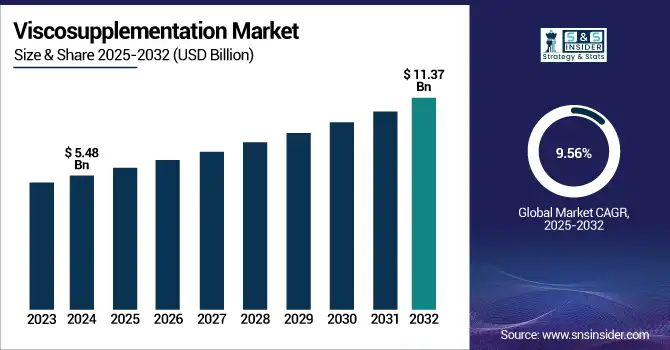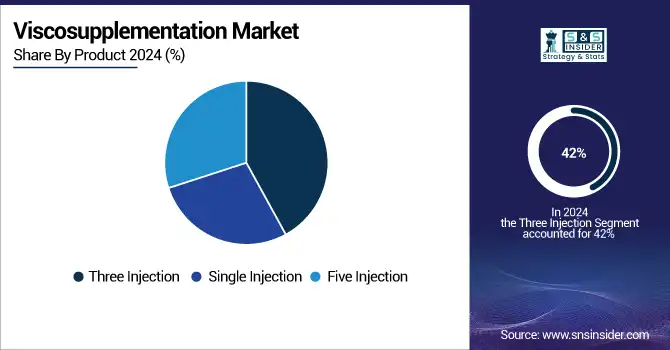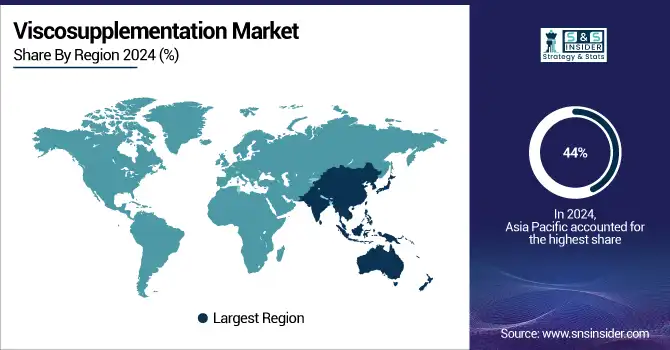Viscosupplementation Market Size Analysis:
The Viscosupplementation Market size was valued at USD 5.48 billion in 2024 and is expected to reach USD 11.37 billion by 2032, growing at a CAGR of 9.56% over the forecast period of 2025-2032.

To Get more information on Viscosupplementation Market - Request Free Sample Report
Rising prevalence of osteoarthritis, an aging population, and a growing inclination for minimally invasive procedures are driving strong viscosupplementation market growth.
For instance, the Centers for Disease Control and Prevention (CDC) estimate that 78.4 million U.S. adults will have arthritis by 2040, underscoring the critical need of efficient knee osteoarthritis treatment and joint pain relieving options.
Positive reimbursement policies in big markets and rising healthcare spending help to support this growth. With a value of USD 1.21 billion in 2024 and expected to reach USD 2.50 billion with a CAGR of 9.46% during the forecast period, reflecting advanced healthcare infrastructure and high adoption rates of viscosupplementation treatment, the U.S. Viscosupplementation Market accounted significant global Viscosupplementation Market share in 2024. New hyaluronic acid injections have been approved by regulatory authorities, including the FDA, therefore extending the spectrum of FDA-approved viscosupplements and hastening the acceptance of intra-articular injections for osteoarthritis control. The Viscosupplementation Market Trends globally are being shaped by these market drivers and restraints, together with continuous innovation in orthopedic biologics and improved patient awareness.
The government health agencies in the United States, Europe, and Asia-Pacific have increased financing for musculoskeletal research. Together with the rising geriatric population and better medical infrastructure, these trends in healthcare spending are driving viscosupplementation treatment for cartilage degeneration and joint pain reduction more and more adoption. Advanced hyaluronic acid injections and minimally invasive techniques, which restore synovial fluid characteristics and improve mobility for individuals with osteoarthritis, are also seeing a movement in the market.
Viscosupplementation Market Dynamics
Drivers
-
Rising Osteoarthritis Prevalence Among Populations Drives Viscosupplementation Procedures Demand
Rising osteoarthritis rates, especially among elderly persons, directly influence the demand for viscosupplementation treatments all around. The Centers for Disease Control and Prevention (CDC) estimates that arthritis will afflict 78.4 million persons aged 18 years and above in the United States by 2040, therefore highlighting the increasing load of joint disorders in aging societies. Particularly in the knees, hips, and hands, osteoarthritis, the most often occurring kind of arthritis, causes pain, limited mobility, and decreased quality of life.
For patients who do not respond to conservative therapies, including oral drugs or physical therapy, viscosupplementation, which entails injecting hyaluronic acid straight into afflicted joints, is progressively sought after as a non-surgical pain management solution. With increasing life expectancies producing more people living with chronic joint disorders, the World Health Organization and national health authorities have underlined the effect of an aging global population. Rising obesity rates that further raise osteoarthritis risk, along with this demographic trend, are driving healthcare professionals to advise viscosupplementation as a sensible alternative for preserving mobility and postponing or avoiding intrusive surgical procedures.
Restraints
-
Particularly in low-income and underinsured populations, the high cost of viscosupplementation limits access.
Viscosupplementation treatment's high cost still poses a major barrier that limits access for patients without complete insurance coverage and in low-income areas. Many viscosupplementation solutions use advanced types of hyaluronic acid, which raises patient fees and hence production expenses. Insurance coverage for these therapies is often limited or nonexistent in underdeveloped nations, hence, patients must pay out-of-pocket for each injection schedule, usually involving several sessions for best outcomes.
Limited healthcare infrastructure and a scarcity of qualified experts qualified to deliver the therapy aggravate this financial barrier, therefore further lowering access in economically deprived places. Consequently, even though viscosupplementation clearly improves populations that may most benefit from it and osteoarthritis is becoming more and more common, adoption among these groups remains poor. Recent industry studies and healthcare policy reports show that the difficulty of reconciling price with quality and innovation still limits the market's growth into underprivileged areas.
Viscosupplementation Market Segmentation Analysis
By Product
With a 42% of viscosupplementation market share, the three-injection viscosupplementation segment dominated in 2024. The known clinical efficacy, long-standing use by medical practitioners, and capacity to offer continuous pain relief in mild osteoarthritis patients help to explain the leadership of this market. With the FDA and European agencies sanctioning several three-injection hyaluronic acid products in recent years, regulatory support has been vital. This has motivated more doctors to advise these schedules as the norm for treating knee osteoarthritis.
Key market drivers for this segment are the rising frequency of osteoarthritis, particularly among the elderly population, and the demand for non-surgical, minimally invasive treatments. Leading viscosupplementation companies include Zimmer Biomet and Sanofi recently introduced next-generation three-injection viscosupplementation products with enhanced biocompatibility and longer-lasting benefits. Due in great part to cost concerns and the sizable patient population, demand for multiple-injection therapy cycles is especially strong in Asia-Pacific, therefore boosting the expansion of the market.
Conversely, over the projected period, the single-injection viscosupplementation segment is expected to grow with the fastest CAGR over the forecast period. Patient preference for convenience, fewer clinical visits, and less chance of adverse events all help to fuel this tendency. Single-injection viscosupplementation products' performance and safety have been enhanced by technological developments in cross-linked hyaluronic acid formulations, which have attracted doctors and patients alike more and more. Reflecting confidence in their clinical performance and safety profile, regulating authorities have approved numerous innovative single-injection hyaluronic acid injections in 2024. Particularly among the working-age population, the viscosupplementation market data shows that growing knowledge of osteoarthritis management and the growing need for quick, non-surgical knee osteoarthritis therapy help to support the growth of this segment.

By end-use
Orthopedic clinics and ambulatory surgical centers (ASCs) segment dominated the market with a 63% of the Viscosupplementation Market share in 2024. Patients looking for same-day, minimally invasive treatments choose these clinics because of their specialized care, economy, and quick delivery of viscosupplementation treatment. Especially in North America and Europe, favorable reimbursement rules and expanded insurance coverage have helped ASCs and orthopedic clinics flourish even more. The trend toward outpatient care aligns with the broader market shift toward non-surgical, rapid recovery solutions for joint pain relief.
Over the projection period hospitals segment is expected to grow at fastest CAGR. Patients with severe osteoarthritis or many comorbidities choose hospitals since they are ready to manage complicated cases and offer interdisciplinary treatment. Increased access to viscosupplementation treatment and intra-articular injections is resulting from continuous expenditures in hospital infrastructure and enlarged orthopedic departments in growing markets.
Regional Insights
With 44% of the global viscosupplementation market share, Asia Pacific dominated. A fast aging population, increasing incidence of osteoarthritis, and major improvements in healthcare infrastructure across developing nations such as China, Japan, India, and South Korea, all help to fuel this outstanding performance. Together, China, Japan, and India accounted for around 71% of Asia Pacific's viscosupplementation market consumption in 2024; China leads because of increased local manufacturing, while India gains from a 14% growth in approved viscosupplement brands. Further driving market expansion include high awareness of single- and multiple-injection treatments, affordable manufacturing, and government regulations supporting such treatments. Furthermore, underlining Asia Pacific's leadership in this field is the growing demand for non-surgical osteoarthritis therapies and creative hyaluronic acid solutions.
Another important region with a substantial portion of the global viscosupplementation market is North America. The excellent healthcare system of the area, high frequency of knee osteoarthritis, and general acceptance of creative, minimally invasive treatments help to explain their predominance. Strong insurance coverage for viscosupplementation therapies, the existence of significant industry participants, and continuous research and development spending help the United States lead the market. The region's market position is improved even further by its emphasis on patient-centric care and early acceptance of innovative hyaluronic acid formulations.
Over the forecast period, Europe is expected to develop with the fastest CAGR of 10.12%. Rising osteoarthritis incidence, growing demand for less intrusive treatments, and favorable reimbursement policies in major nations like Germany and France help to boost the market in this region. While strategic alliances and legislative activities are driving product development and market expansion, European producers are releasing next-generation viscosupplements with enhanced viscosity and extended duration of action. Germany, in particular, is transitioning toward biomechanical and regenerative medicine approaches, reflecting the region’s emphasis on innovation.

Get Customized Report as per Your Business Requirement - Enquiry Now
Viscosupplementation Market Key Players
The key Viscosupplementation Companies are Seikagaku Corp., Fidia Farmaceutici S.p.A, Lifecore Biomedical, Sanofi, Smith & Nephew PLC, Anika Therapeutics, Inc., Zimmer Biomet, F. Hoffmann-La Roche Ltd., Ferring Pharmaceuticals B.V., LG Life Sciences Ltd., DePuy Synthes, and others
Recent Developments in the Viscosupplementation Market
-
Reflecting ongoing regulatory confidence in these treatments, the U.S. FDA approved numerous new viscosupplementation products in 2024, including both single- and three-injection hyaluronics acid injections.
-
While Seikagaku stated distributing over 2 million units of its flagship viscosupplementation products in the first half of 2024, Zimmer Biomet and Sanofi debuted new three-injection viscosupplementation products early in 2024.
| Report Attributes | Details |
|---|---|
| Market Size in 2024 | USD 5.48 Billion |
| Market Size by 2032 | USD 11.37 Billion |
| CAGR | CAGR of 9.56% From 2025 to 2032 |
| Base Year | 2024 |
| Forecast Period | 2025-2032 |
| Historical Data | 2021-2023 |
| Report Scope & Coverage | Market Size, Segments Analysis, Competitive Landscape, Regional Analysis, DROC & SWOT Analysis, Forecast Outlook |
| Key Segments | • By Product (Three Injection, Single Injection, and Five Injection) • By End-use (Hospitals, and Orthopedic Clinics/ASCs) |
| Regional Analysis/Coverage | North America (US, Canada, Mexico), Europe (Germany, France, UK, Italy, Spain, Poland, Turkey, Rest of Europe), Asia Pacific (China, India, Japan, South Korea, Singapore, Australia, Rest of Asia Pacific), Middle East & Africa (UAE, Saudi Arabia, Qatar, South Africa, Rest of Middle East & Africa), Latin America (Brazil, Argentina, Rest of Latin America) |
| Company Profiles | Seikagaku Corp., Fidia Farmaceutici S.p.A, Lifecore Biomedical, Sanofi, Smith & Nephew PLC, Anika Therapeutics, Inc., Zimmer Biomet, F. Hoffmann-La Roche Ltd., Ferring Pharmaceuticals B.V., LG Life Sciences Ltd., DePuy Synthes, and others |

